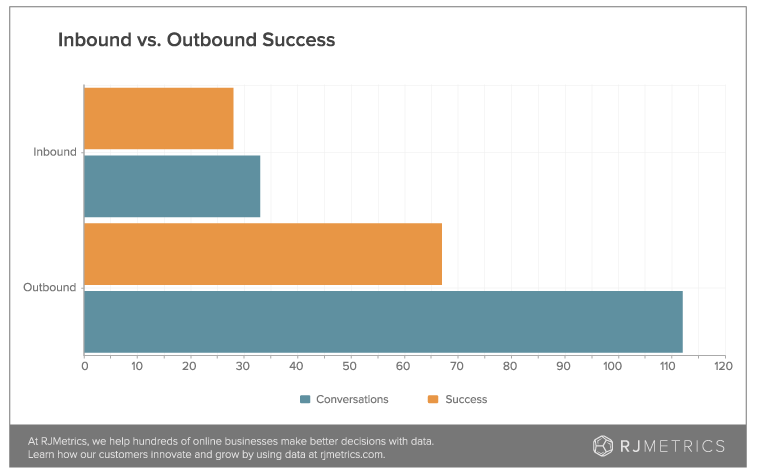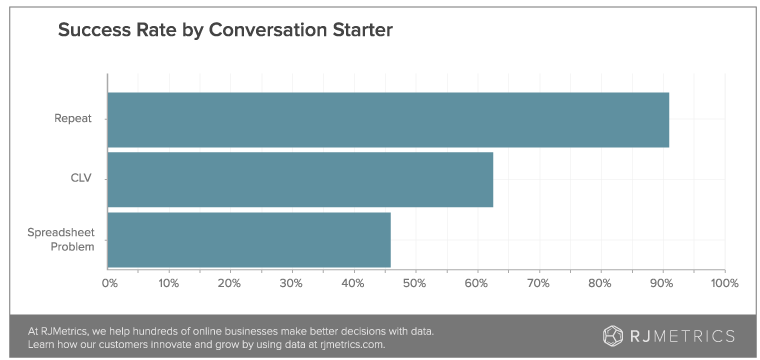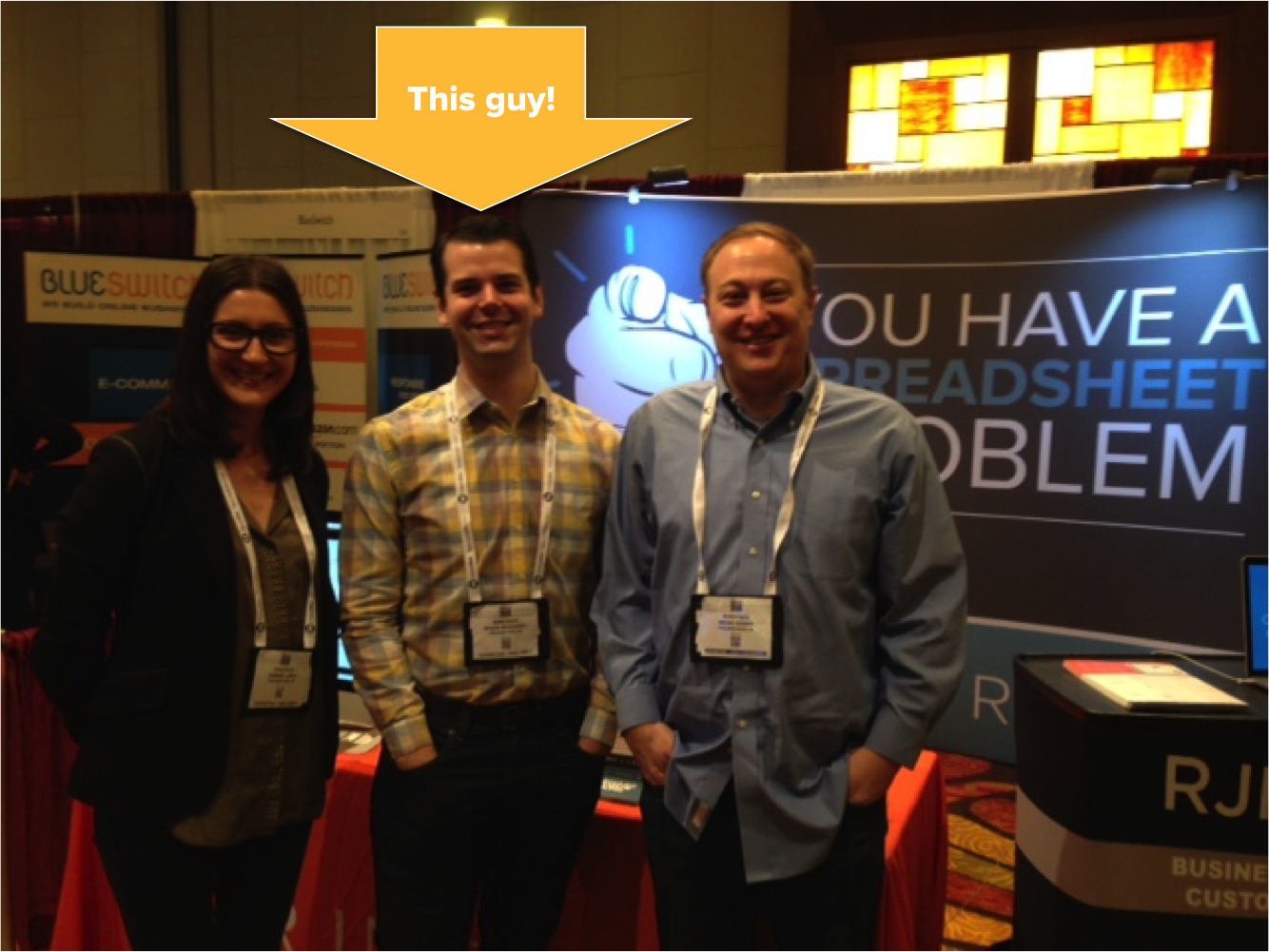This was the question our founders were asking themselves at the very first conference RJMetrics ever attended. Conferences are expensive and time consuming and, depending on what you’re selling, it can take months before you see a positive ROI.
What we learned at that first event continues to shape our conference strategy. We’re a business intelligence company so, unsurprisingly, we use data to evaluate how well we perform.
There are a few things we track at every event we attend:
- The cost per minute of attending: We use this as a benchmark that helps us evaluate a variety of events against the same metric. For example, the first IRCE event we sponsored cost $6.50 per minute. Our most recent event in Orlando cost $10 per minute.
- The cost per conversation: To make these events worth it, you have to be aggressive about starting conversations. We don’t give demos at these events, our primary goal is simply to talk to as many people as possible.
- The cost per pitch: Of course, we’re not just chatting about the weather. We’re out to raise awareness about RJMetrics. We measure the success of a conversation based on whether or not the person we’re talking to is interested in hearing a 30-second pitch.
- The cost per meeting: The end goal is always to get a meeting. Getting a meeting on the calendar of a qualified prospect right there, at the booth, is our biggest win. It’s the quickest way for us to predict what the ROI of an event will be.
Early last month a few of us from RJMetrics headed off to Internet Retailer’s Web Design & Mobile Conference in Orlando fully armed with data collection tools (Google Forms). Over the course of three days we collected data on who we were talking to, how we started the conversation, group size, time of day, etc. Here are a few things we learned.
#1: Conversations don’t just start themselves
Plenty of sponsors take the “sit and wait” approach, we don’t recommend this. At IRWD, our conference hustle proved itself once again. Over the course of the 3 days we had a total of 145 conversations. 33 of these were from people walking up to our booth to talk (inbound). The rest of the time we were working aggressively to engage attendees in conversation. Did we annoy some people? Likely. Was it worth it? Absolutely.
If we had been relying on walk-ups alone, the cost of each conversation would have been $303. Our outbound conversations were less likely to be successful, but the additional rejection was worth it. By actively engaging attendees we doubled our number of successful conversations and knocked the cost of conversation back to a more tolerable $70.

In addition, the majority of our meetings came from outbound efforts as well. If we had been relying solely on inbound efforts the cost per meeting would have been over $1500. As it was, the cost per meeting came in just over $650.
#2: Always be testing
We’re constantly testing the best way to engage conference attendees in conversation. In the past we’ve found that “What’s your customer lifetime value?” works best for us. We think it works so well for a few reasons:
- It’s open-ended: People feel social pressure to answer questions. Even people who are not interested in talking to us will often give a response as they keep walking.
- It’s forward, but not overly so: It’s personal, it makes people stop and nearly every ecommerce company at least knows its something they should be tracking.
- It’s a good segue: We’re out to start real conversations about both the business of ecommerce and what RJMetrics does, this questions allows for a quick transition from opener to pitch.
- It allows people to instantly disqualify themselves: Conferences and trade shows will have plenty of third party companies that aren’t our target market.This question allows us to immediately weed them out.
We’ve also had good success with the question, “How much of your business is from repeat purchases?” At this event, we wanted to add a new question into the mix. We had a new booth cover (see below) and wanted to test how the starter, “Does your company have a spreadsheet problem?” would work.

I was particularly fond of this question. So fond, in fact, that I started 43% of my conversations with this line, more than the other two gentleman in my group. Ultimately, it was to my disadvantage.

While the question made a lot of people laugh and smile as they walked by, they still walked by. Many of them would even stop for a quick chat, but the question was broad enough that they could excuse themselves before the pitch. Less than half of the spreadsheet problem conversations were successful. The question gave them an out. Lesson learned – don’t use yes or no openers.
#3: Know your audience
Our data on the conference revealed one particular item of interest. People became quite happy to chat right before happy hour. The exhibit hall tended to be a bit emptier at this time so while there were fewer opportunities to start conversations, the people who were there were ready to talk.
Perhaps it’s because no one wants to be the guy who looks like they’re waiting for the bar to open so it’s easier to just talk to the vendor. Whatever the reason, it’s important to know your audience at these kinds of events. Just because it’s downtime doesn’t mean it’s time to stop working. Always be hustling, especially when someone is about to start serving drinks.

#4: And the winner is…
One of the natural by-products of measuring everything is that everything becomes a competition. So, which of these charming, shadowy-faced individuals owned IRWD?


Shaun McAvinney’s smiling face started half of the conversations at IRWD. 70% of them were successful and he got twice as many meetings on the calendar as either Brian or myself. While Brian and I stuck to our more familiar strategies – Brian working the inbound leads, me fixated on the spreadsheet problem – Shaun tested the full spectrum of pick-up lines.
It’s also worth noting that while Shuan was the most successful, he also had a whole lot of failures. I took the lead on this one with 25 conversations failing (Give me a break, I’m a marketer not a sales person!), but Shaun was a close second with 22 failures. Shaun is evidence that at these events, persistence will pay off.
So, are conference sponsorships worth it?
Using data in this way has helped us feel much more confident about investing in conference sponsorships. It gives us the ability to evaluate the success of an event in a timeframe much shorter than our 3-6 month sales cycle. As we get better at this, we’ll be able to check our performance every day of an event, evaluating what’s working, and making adjustments for the remaining time.
Conferences aren’t cheap, if you want to make them worth it – get ready to hustle.
